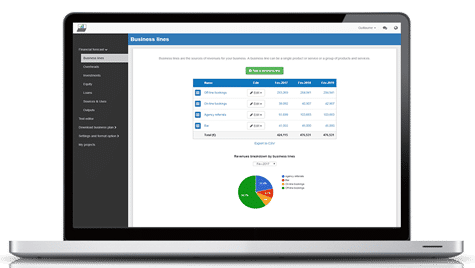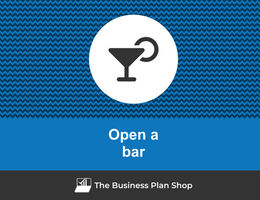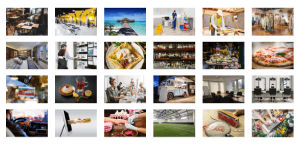How to create a financial forecast for a bar?
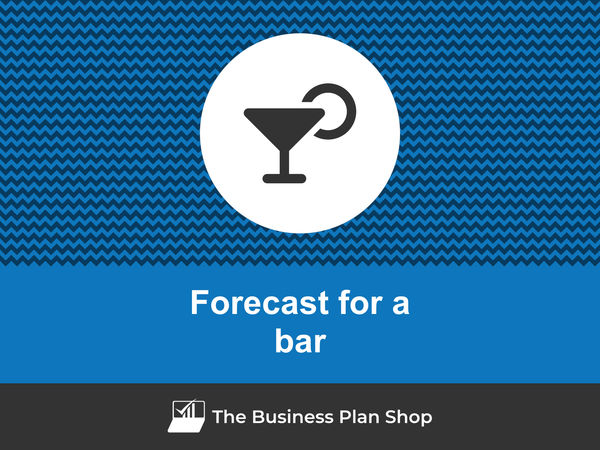
If you are serious about keeping visibility on your future cash flows, then you need to build and maintain a financial forecast for your bar.
Putting together a bar financial forecast may sound complex, but don’t worry, with the right tool, it’s easier than it looks, and The Business Plan Shop is here to guide you.
In this practical guide, we'll cover everything you need to know about building financial projections for your bar.
We will start by looking at why they are key, what information is needed, what a forecast looks like once completed, and what solutions you can use to create yours.
Let's dive in!
Why create and maintain a financial forecast for a bar?
In order to prosper, your business needs to have visibility on what lies ahead and the right financial resources to grow. This is where having a financial forecast for your bar becomes handy.
Creating a bar financial forecast forces you to take stock of where your business stands and where you want it to go.
Once you have clarity on the destination, you will need to draw up a plan to get there and assess what it means in terms of future profitability and cash flows for your bar.
Having this clear plan in place will give you the confidence needed to move forward with your business’s development.
Having an up-to-date financial forecast for a bar is also useful if your trading environment worsens, as the forecast enables you to adjust to your new market conditions and anticipate any potential cash shortfall.
Finally, your bar's financial projections will also help you secure financing, as banks and investors alike will want to see accurate projections before agreeing to finance your business.
Need a solid financial forecast?
The Business Plan Shop does the maths for you. Simply enter your revenues, costs and investments. Click save and our online tool builds a three-way forecast for you instantly.
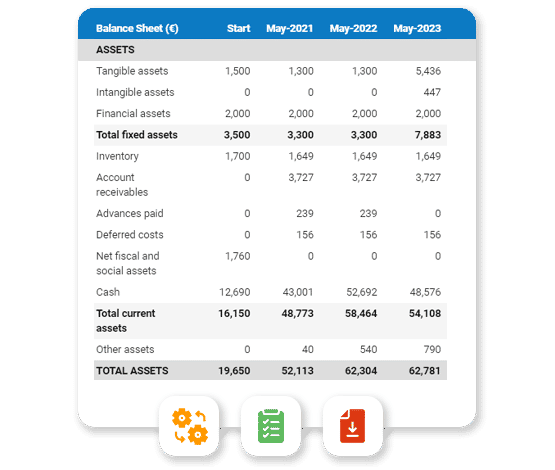
What information is used as input to build a bar financial forecast?
A bar's financial forecast needs to be built on the right foundation: your assumptions.
The data required to create your assumptions will depend on whether you are a new or existing bar.
If you are creating (or updating) the forecast of an existing bar, then your main inputs will be historical accounting data and operating metrics, and your team’s view on what to expect for the next three to five years.
If you are building financial projections for a new bar startup, you will need to rely on market research to form your go-to-market strategy and derive your sales forecast.
For a new venture, you will also need an itemised list of resources needed for the bar to operate, along with a list of equipment required to launch the venture (more on that below).
Now that you understand what is needed, let’s have a look at what elements will make up your bar's financial forecast.
The sales forecast for a bar
From experience, it is usually best to start creating your bar financial forecast by your sales forecast.
To create an accurate sales forecast for your bar, you will have to rely on the data collected in your market research, or if you're running an existing bar, the historical data of the business, to estimate two key variables:
- The average price
- The number of monthly transactions
To get there, you will need to consider the following factors:
- Seasonal demand: Depending on the location of your bar, certain times of the year may see a higher demand for your services. For example, a bar located near a beach may experience higher sales during the summer months when tourists are visiting.
- Local events: Keep an eye out for local events such as concerts, festivals, or sports games that may bring in a larger crowd to your bar. These events can drive up your sales and increase the average price per transaction.
- Menu changes: Introducing new or seasonal items to your menu can attract customers and increase their average spend at your bar. Consider offering unique or specialty drinks that are only available for a limited time.
- Competition: The presence of other bars or restaurants in the area can impact your business. Keep an eye on what your competitors are offering and adjust your prices accordingly to stay competitive.
- Seasonal ingredients: If your bar offers food items, the availability and cost of seasonal ingredients can affect the prices of your menu items. Consider adjusting your menu to include more cost-effective ingredients during certain times of the year to maintain your profit margins.
Once you have an idea of what your future sales will look like, it will be time to work on your overhead budget. Let’s see what this entails.
Need inspiration for your business plan?
The Business Plan Shop has dozens of business plan templates that you can use to get a clear idea of what a complete business plan looks like.
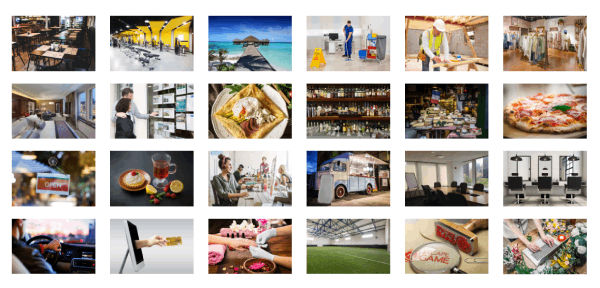
The operating expenses for a bar
The next step is to estimate the expenses needed to run your bar on a day-to-day basis.
These will vary based on the level of sales expected, and the location and size of your business.
But your bar's operating expenses should include the following items at a minimum:
- Staff costs: This includes the wages, salaries, and benefits of your bartenders, servers, cooks, and other staff members.
- Accountancy fees: You may need to hire an accountant to help you with bookkeeping, tax preparation, and other financial tasks for your bar.
- Insurance costs: It's important to have insurance coverage for your bar to protect against potential risks such as liability claims, property damage, and theft.
- Software licences: Depending on the type of software you use for managing your bar operations, you may need to pay for annual or monthly licences.
- Banking fees: Your bar may incur fees for bank account maintenance, credit card processing, and other banking services.
- Inventory costs: This includes the cost of purchasing and maintaining your bar's inventory of alcohol, mixers, garnishes, and other supplies.
- Marketing and advertising expenses: To attract customers to your bar, you may need to spend money on advertising, promotions, and other marketing efforts.
- Rent or lease payments: If you don't own the building where your bar is located, you'll need to budget for rent or lease payments.
- Utilities: Your bar will have ongoing expenses for electricity, gas, water, and other utilities.
- Maintenance and repairs: Keeping your bar clean and in good working condition may require occasional maintenance and repairs, which can be costly.
- Liquor license fees: Depending on your location, you may need to pay annual fees to maintain your liquor license.
- Music licensing fees: If you play music in your bar, you'll need to pay licensing fees to the appropriate organizations.
- Security costs: To ensure the safety of your staff and customers, you may need to invest in security measures such as cameras, alarms, and security personnel.
- Cleaning supplies: Keeping your bar clean and sanitary is crucial, and you'll need to budget for the cost of cleaning supplies.
- Training and development: It's important to invest in the training and development of your staff to maintain high-quality service and improve their skills.
This list is, of course, not exhaustive, and you'll have to adapt it according to your precise business model and size. A small bar might not have the same level of expenditure as a larger one, for example.
What investments are needed to start or grow a bar?
Once you have an idea of how much sales you could achieve and what it will cost to run your bar, it is time to look into the equipment required to launch or expand the activity.
For a bar, capital expenditures and initial working capital items could include:
- Bar Equipment: This includes items such as bar stools, tables, chairs, refrigerators, keg coolers, and ice machines. These are essential for running a bar and should be included in your expenditure forecast.
- Bar Supplies: This includes items such as glassware, utensils, napkins, straws, and other items needed for serving and preparing drinks. These supplies will need to be constantly replenished, so it is important to factor them into your forecast.
- Bar Renovations: If you are starting a new bar or planning to renovate an existing one, you will need to budget for things like flooring, lighting, furniture, and decor. These are one-time expenses, but they can significantly impact the overall cost of starting or improving your bar.
- Point of Sale (POS) System: A good POS system is essential for managing sales, inventory, and employee schedules. It can also help with tracking customer data and analyzing sales trends. You will need to invest in a quality POS system to ensure smooth operations and accurate financial tracking for your bar.
- Security System: Keeping your bar and your customers safe is a top priority. A good security system, including cameras, alarms, and door locks, is a must for any bar. It is important to include the cost of installation and ongoing monitoring fees in your expenditure forecast.
Again, this list will need to be adjusted according to the specificities of your bar.
Need a convincing business plan?
The Business Plan Shop makes it easy to create a financial forecast to assess the potential profitability of your projects, and write a business plan that’ll wow investors.
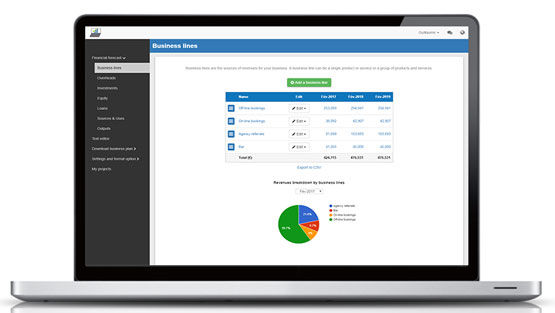
The financing plan of your bar
The next step in the creation of your financial forecast for your bar is to think about how you might finance your business.
You will have to assess how much capital will come from shareholders (equity) and how much can be secured through banks.
Bank loans will have to be modelled so that you can separate the interest expenses from the repayments of principal, and include all this data in your forecast.
Issuing share capital and obtaining a bank loan are two of the most common ways that entrepreneurs finance their businesses.
What tables compose the financial plan for a bar?
Now let's have a look at the main output tables of your bar's financial forecast.
The profit & loss forecast
The forecasted profit & loss statement will enable you to visualise your bar's expected growth and profitability over the next three to five years.

A financially viable P&L statement for a bar should normally show:
- Sales growing above inflation
- Stable or expanding (ideally) profit margins
- A net profit
This will of course depend on the stage of your business: a new venture might be loss-making until it reaches its breakeven point in year 2 or 3, for example.
The projected balance sheet
Your bar's forecasted balance sheet enables you to assess your financial structure and working capital requirements.
It is composed of three types of elements: assets, liabilities and equity:
- Assets: represent what the business owns and uses to produce cash flows. It includes resources such as cash, equipment, and accounts receivable (money owed by clients).
- Liabilities: represent funds advanced to the business by lenders and other creditors. It includes items such as accounts payable (money owed to suppliers), taxes due and loans.
- Equity: is the combination of what has been invested by the business owners and the cumulative profits and losses generated by the business to date (which are called retained earnings). Equity is a proxy for the value of the owner's stake in the business.
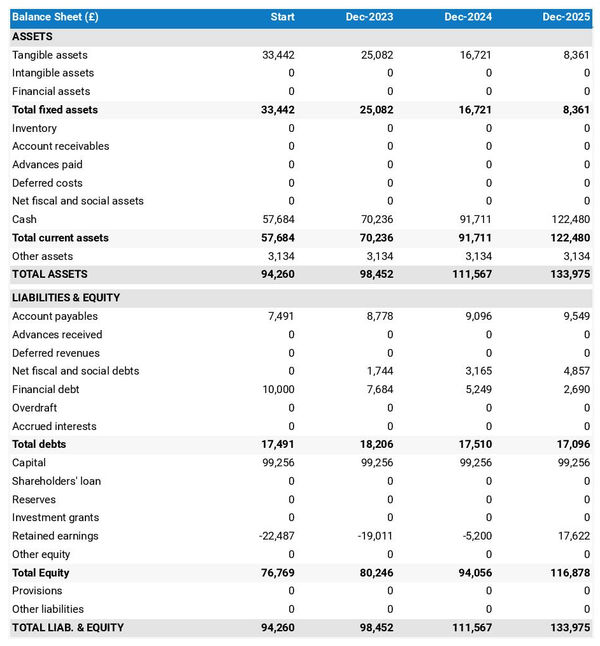
The cash flow forecast
Your bar's cash flow forecast shows how much cash your business is expected to consume or generate in the years to come.

It is best practice to organise the cash flow forecast by nature to better explain where cash is used or generated by the bar:
- Operating cash flow: shows how much cash is generated by the operating activities
- Investing cash flow: shows how much will be invested in capital expenditure to maintain or expand the business
- Financing cash flow: shows if the business is raising new capital or repaying financiers (debt repayment, dividends)
Keeping an eye on (and regularly updating) your bar's cash flow forecast is key to ensuring that your business has sufficient liquidity to operate normally and to detect financing requirements as early as possible.
If you are trying to raise capital, you will normally be asked to provide a monthly cash flow forecast in your bar's financial plan - so that banks or investors can assess seasonal variation and ensure your business is appropriately capitalised.
Need a solid financial forecast?
The Business Plan Shop does the maths for you. Simply enter your revenues, costs and investments. Click save and our online tool builds a three-way forecast for you instantly.

Which tool should you use to create your bar's financial projections?
Building a bar financial forecast is not difficult provided that you use the right tool for the job. Let’s see what options are available below.
Using online financial projection software to build your bar's forecast
The modern and easiest way to build a forecast is to use professional financial projection software such as the one we offer at The Business Plan Shop.
There are several advantages to using specialised software:
- You can easily create your financial forecast by letting the software take care of the financial calculations for you without errors
- You have access to complete financial forecast templates
- You get a complete financial forecast ready to be sent to your bank or investors
- You can easily track your actual financial performance against your financial forecast, and recalibrate your forecast as the year goes by
- You can create scenarios to stress test your forecast's main assumptions
- You can easily update your forecast as time goes by to maintain visibility on future cash flows
- You have a friendly support team on standby to assist you when you are stuck
- It’s cost-efficient and much cheaper than using an accountant or consultant (see below)
If you are interested in this type of solution, you can try our forecasting software for free by signing up here.
Calling in a financial consultant or chartered accountant
Enlisting the help of a consultant or accountant is also a good way to obtain a professional bar financial forecast.
The downside of this solution is its cost. From experience, obtaining a simple financial forecast over three years (including a balance sheet, income statement, and cash flow statement) is likely to cost a minimum of £700 or $1,000.
The indicative cost above, is for a small business, and a forecast is done as a one-shot exercise. Using a consultant or accountant to track your actuals vs. forecast and to keep your financial projections up to date on a monthly or quarterly basis will cost a lot more.
If you opt for this solution, make sure your accountant has in-depth knowledge of your industry, so that they may challenge your figures and offer insights (as opposed to just taking your assumptions at face value to create the forecast).
Why not use a spreadsheet such as Excel or Google Sheets to build your bar's financial forecast?
Creating an accurate and error-free bar financial forecast with a spreadsheet is very technical and requires a deep knowledge of accounting and an understanding of financial modelling.
Very few business owners are financially savvy enough to be able to build a forecast themselves on Excel without making mistakes.
Lenders and investors know this, which is why forecasts created on Excel by the business owner are often frowned upon.
Having numbers one can trust is key when it comes to financial forecasting and to that end using software is much safer.
Using financial forecasting software is also faster than using a spreadsheet, and, with the rise of artificial intelligence, software is also becoming smarter at helping us analyse the numbers to make smarter decisions.
Finally, like everything with spreadsheets, tracking actuals vs. forecasts and keeping your projections up to date as the year progresses is manual, tedious, and error-prone. Whereas financial projection software like The Business Plan Shop is built for this.
Need a convincing business plan?
The Business Plan Shop makes it easy to create a financial forecast to assess the potential profitability of your projects, and write a business plan that’ll wow investors.

Use our financial projection templates for inspiration
The Business Plan Shop has dozens of financial forecasting templates available.
Our examples contain both the financial forecast, and a written business plan which presents, in detail, the company, the team, the strategy, and the medium-term objectives.
Whether you are just starting out or already have your own bar, looking at our template is always a good way to get ideas on how to model financial items and what to write when creating a business plan to secure funding.

Takeaways
- A financial projection shows expected growth, profitability, and cash generation for your business over the next three to five years.
- Tracking actuals vs. forecast and keeping your financial forecast up-to-date is the only way to maintain visibility on future cash flows.
- Using financial forecasting software makes it easy to create and maintain up-to-date projections for your bar.
You have reached the end of our guide. We hope you now have a better understanding of how to create a financial forecast for a bar. Don't hesitate to contact our team if you have any questions or want to share your experience building forecasts!
Need inspiration for your business plan?
The Business Plan Shop has dozens of business plan templates that you can use to get a clear idea of what a complete business plan looks like.

Also on The Business Plan Shop
Know someone who runs or wants to start a bar? Share our financial projection guide with them!

